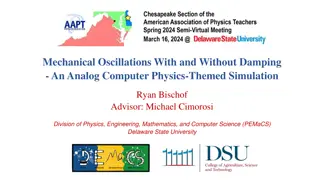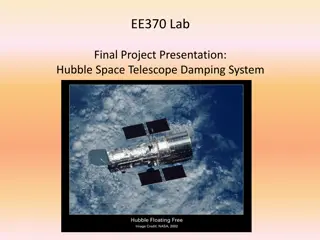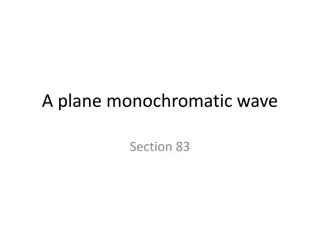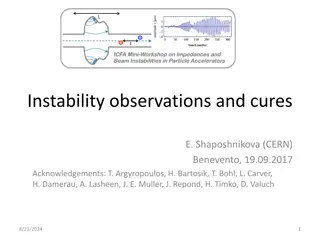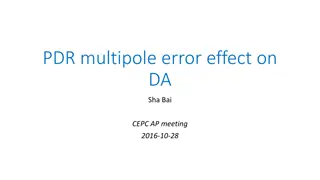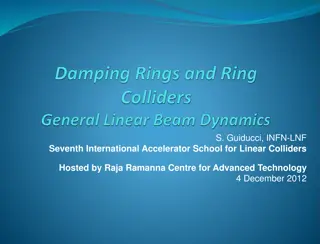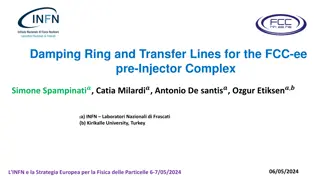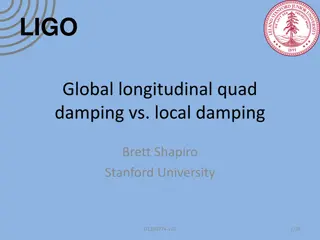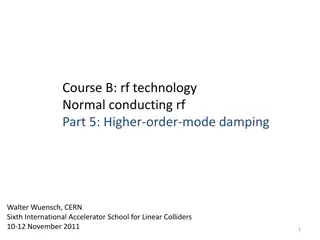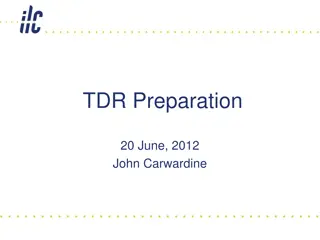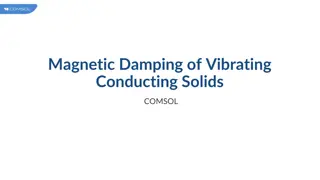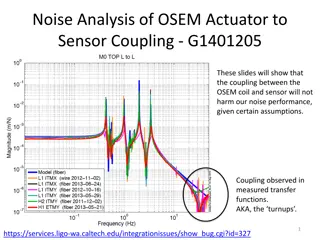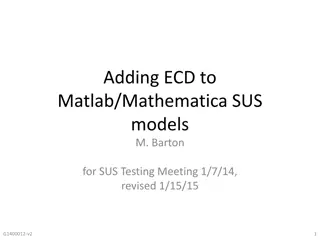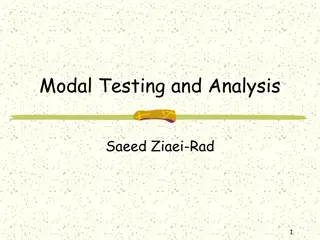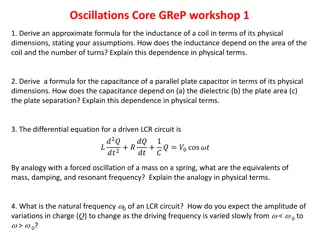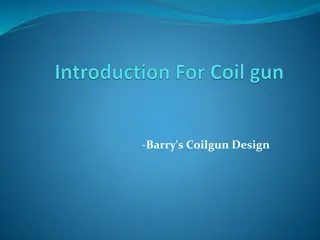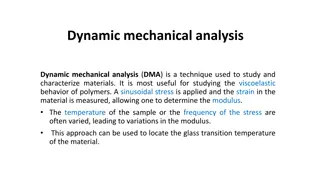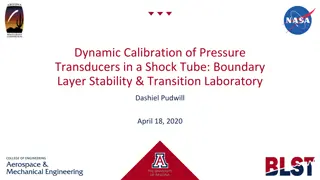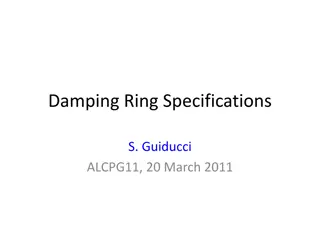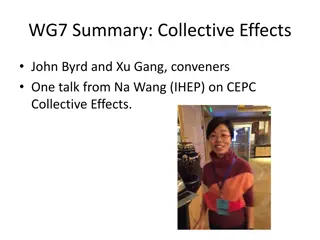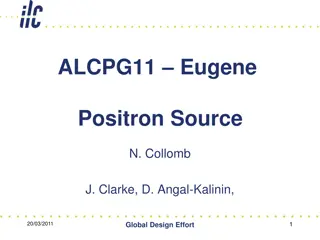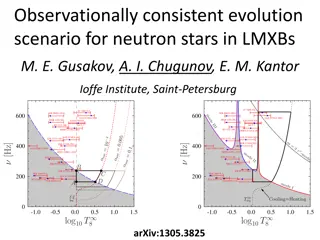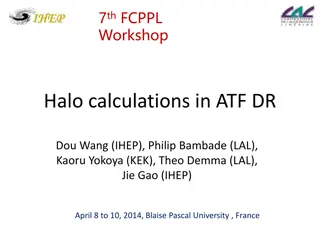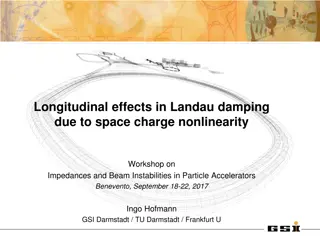Spring 2BL :Lecture 6
In this lecture, you will delve into Experiment #3, focusing on constructing and tuning a shock absorber to test a model for damping in a car's suspension system. The goal is to achieve critical damping for optimal performance, reducing oscillations and returning the system to equilibrium efficientl
5 views • 24 slides
Analog Computer Simulation of Mechanical Oscillations with Damping
Explore the analog computer simulation of mechanical oscillations with and without damping in a physics-themed project. Students can visualize classical physics concepts through hands-on analog circuit design, modeling spring-mass systems and RLC circuits. The project involves constructing a breadbo
15 views • 11 slides
Hubble Space Telescope Damping System for Oscillation Reduction
This presentation focuses on the design and implementation of a compensator system to reduce deleterious oscillations affecting observations from the Hubble Space Telescope. Utilizing MATLAB for frequency response analysis, the project aims to dampen oscillations occurring at distinct frequencies, e
3 views • 12 slides
Complex Wavevectors in Homogeneous Media
Exploring the concept of complex wavevectors in a homogeneous medium, this content delves into monochromatic waves, Maxwell equations, wave propagation, and the relationship between material properties and wave behavior. It discusses how the complex nature of wavevectors impacts fields, damping, and
3 views • 17 slides
Addressing Instability in Particle Accelerators
In this document, E. Shaposhnikova from CERN discusses observations and cures for instability in particle accelerators. The content covers types of instabilities, observations like direct and indirect effects, and possible cures such as modifying the source, passive and active damping, and changing
3 views • 30 slides
Analysis of Multipole Error Effects on Beam Dynamics in CEPC Accelerator
The content discusses the impact of multipole errors on the beam dynamics at the CEPC Accelerator, focusing on sources of error, measurements, and potential effects on the beam. The analysis includes different types of multipole errors, their sources, and the resulting changes in tune and emittance
4 views • 11 slides
Overview of Damping Rings in Linear Colliders
This content provides insights into the basics of damping rings in linear colliders, covering topics such as ring equations of motion, betatron motion, emittance, transverse coupling, dispersion, and momentum compaction factor. It delves into the equations of motion governing particle behavior in el
4 views • 34 slides
Overview of Damping Ring and Transfer Lines for FCC-ee Pre-Injector Complex
The Damping Ring and Transfer Lines play a crucial role in the FCC-ee Pre-Injector Complex, aiming to damp the emittance of both beams and operate the damping ring at higher energy levels. Coordinated by experts like C. Milardi and A. De Santis, the project includes designs for the Damping Ring, Tra
1 views • 29 slides
LIGO Global vs. Local Damping Study
LIGO conducted a study comparing global and local damping effects in their system. The research delved into common arm length damping, differential arm length dynamics, and simulated common length damping scenarios. Various configurations and sensor noise considerations were explored to understand t
4 views • 62 slides
Managing Higher-order Modes in Normal Conducting RF Technology
The excitation of higher-order transverse modes due to misalignments between the beam and RF structures can lead to beam instability in linear colliders. This instability can be mitigated by selectively damping the transverse modes and/or detuning the dipole mode frequencies. Understanding the diffe
3 views • 34 slides
TDR Preparation Updates and Milestones for June 2012
Many new submissions in the past week for the TDR preparation, including developments in high-gradient SCRF cavity R&D, cryomodule research, and damping rings. The editorial team welcomes new additions and outlines upcoming milestones for the project, with key dates for reviews and submissions. Pref
3 views • 5 slides
Magnetic Damping in Conducting Solids
When a conductive solid moves through a magnetic field, eddy currents are induced, creating an interaction that leads to magnetic damping. This phenomenon, known as magnetic damping of vibrating conducting solids, plays a crucial role in various applications and can be analyzed using tools like COMS
4 views • 9 slides
Electron Lenses in Particle Accelerators: Advancements and Applications
Explore the use of electron lenses in particle accelerators for space-charge compensation, Landau damping, halo collimation, and beam-beam compensation. Learn about their history, applications in Tevatron and RHIC colliders, and current research areas. Electron lenses have shown promise in enhancing
1 views • 44 slides
Noise Analysis of OSEM Actuator-Sensor Coupling
These slides detail the analysis of the coupling between the OSEM actuator and sensor, focusing on noise performance and assumptions made in the damping model. The measured open loop transfer functions and derivation of closed-loop noise transmission with OSEM coupling are discussed. Simulations and
0 views • 8 slides
Advancements in Adding ECD to Matlab/Mathematica SUS Models
Enhancements in incorporating Eddy Current Damping (ECD) into Matlab and Mathematica SUS models for HAUX/HTTS testing have been made to streamline the integration process. This includes addressing challenges with damping implementation, exporting symbolic matrices, and utilizing state-space formalis
2 views • 11 slides
Modal Testing and Analysis in Structural Dynamics
Modal testing and analysis play a crucial role in understanding the behavior of structural systems under various conditions like undamped, viscously damped, and hysterically damped scenarios. This analysis involves the study of single-degree-of-freedom systems, undamped systems for free and forced v
8 views • 23 slides
Overview of Fair Funding Review Consultation Paper
CCN commissioned Pixel Financial Management to model potential implications of the Fair Funding Review (FFR) to support their responses to current and future consultations. The FFR consultation paper by MHCLG deals with needs in the formula, with future papers focusing on resources and damping. The
1 views • 26 slides
Inductance and Capacitance in Electric Circuits
Explore the derivation of inductance and capacitance formulas in terms of physical dimensions and learn about the dependencies on coil area, number of turns, dielectric, plate area, and plate separation. Understand how inductance relates to magnetic flux and coils while capacitance is linked to char
1 views • 16 slides
Coilguns: A Comprehensive Overview of Coilgun Design and Operation
Coilguns, also known as Gauss guns, accelerate pieces of iron or steel using electromagnetic coils, creating a powerful magnetic field. This overview covers the principles behind coilguns, including magnetic materials, solenoid physics, energy storage in capacitors, and the role of inductors in damp
1 views • 26 slides
Dynamic Mechanical Analysis (DMA) for Material Characterization
Dynamic Mechanical Analysis (DMA) is a valuable technique for studying viscoelastic behavior in materials, particularly polymers. By applying sinusoidal stress and measuring strain, DMA helps determine modulus and locate the glass transition temperature. The method involves varying temperature or st
1 views • 8 slides
Dynamic Calibration of Pressure Transducers in a Shock Tube
This study focuses on the dynamic calibration of pressure transducers in a shock tube to understand boundary layer stability and transition. By creating a shock to impact a Kulite pressure transducer mounted at the end of the tube, researchers aim to determine key parameters such as resonance, dampi
3 views • 11 slides
ILC Damping Ring Specifications and Recommendations
Specifications and recommendations for the ILC Damping Rings include nominal parameters for injected and extracted beams, positron acceptance criteria, longitudinal acceptance guidelines, energy acceptance with quantum lifetime considerations, and layout components for injection/extraction systems.
2 views • 13 slides
Collective Effects in High-Energy Physics Facilities
Collective effects play a crucial role in Higgs factories and high-energy physics facilities. Impedance effects are proportional to beam-induced voltage, with peak bunch current impacting SB effects and average current affecting MB effects. Factors like beam loading compensation and detuning of the
3 views • 5 slides
Modeling a Harmonic Oscillator
This article delves into various models of harmonic oscillators, including simple, damped, and non-linear damping systems, with practical applications and phase portrait analyses.
15 views • 18 slides
Modeling Harmonic Oscillations and its Applications
Dive into the world of harmonic oscillations with a focus on the crucial damping coefficient. Explore simple undamped and damped harmonic motion, along with the analysis of mass-spring systems and bifurcations, all illustrated with informative visuals.
1 views • 16 slides
Second-Order Transients in Electrical Circuits
An exploration of second-order transients in electrical circuits excited by initial conditions. Learn how to analyze RLC series circuits, find natural initial conditions, determine damping cases, and obtain specific solutions. Detailed algorithms and step-by-step examples provided.
2 views • 38 slides
Numerical Simulation and Solver Algorithms
This informational content covers the selection of solvers for simulations, the iterative solution process, head values adjustment, and various solver algorithms like SIP1, SOR1, PCG2, PCGN, NWT, GMG, DE4, LMG, SMS, and more. It also explains parameters like maximum iterations, convergence tolerance
2 views • 17 slides
ALCPG11 Eugene Positron Source: Global Design Effort Overview
The ALCPG11 Eugene Positron Source project involves a detailed breakdown of the source components, work breakdown structure, and summaries of work completed and to be done. The project covers the design, CAD model overview, and walkthrough from the Main LINAC to Damping Ring. It includes sections on
0 views • 21 slides
Power System Stabilizer Functions and Tuning
This lecture discusses the functions of a Power System Stabilizer (PSS), its role in adding damping to the excitation system, the importance of tuning PSS parameters for system stability, and provides examples of single and dual input PSS configurations. Modal analysis, participation factors, and th
0 views • 52 slides
Estimation of Fundamental Frequency, Damping Ratio, and Equivalent Mass in Structural Dynamics
This laboratory experiment focuses on estimating fundamental natural frequency, damping ratio, and equivalent mass in structural dynamics using single degree of freedom modeling and acceleration measurements. The experiment involves identifying mode characteristics, measuring responses, and applying
3 views • 12 slides
Introduction to Control Systems and Classification - K.S. School of Engineering and Management
Explore the fundamentals of control systems and their classification in the Department of Electrical and Electronics Engineering at K.S. School of Engineering and Management. Learn about mathematical models, transfer functions, feedback control systems, and more in this comprehensive study session f
9 views • 13 slides
Neutron Star Evolution Scenarios in LMXBs: R-Mode Instability and Superfluid Modes
Explore observationally consistent evolution scenarios for neutron stars in Low-Mass X-ray Binaries (LMXBs), addressing r-mode instability, avoided crossings of normal and superfluid modes, resonance damping, and new instability windows. Understand the complexity of neutron star evolution through va
3 views • 12 slides
Vibrations in Mechanical Systems: Analysis and Solutions
Explore the lecture material on vibrations in mechanical systems, focusing on concepts like frequency ratio, damping ratio, and steady-state response. Understand the calculations and solutions related to harmonic excitation and forced vibration under base motion.
2 views • 47 slides
Challenges of SLC Damping Ring Direct Loop System
Explore the system overview and problem faced by the SLC Damping Ring Direct Loop, addressing issues with beam loading instability and cavity voltage tuning. Delve into the modeled behavior, phasor representations of currents, and gain and stability limits within the system, offering insights into i
4 views • 11 slides
System Analysis Exercises and Solutions
Explore a series of exercises and solutions on system analysis, including finding transfer functions, damping ratios, settling times, stability analysis, error constants, and more for different types of systems. Dive into each exercise to enhance your understanding of control systems.
3 views • 6 slides
ATF Damping Ring Beam Halo Generation and Distribution Study
Explore the generation and distribution of beam halo in ATF damping ring, investigating main sources like beam-gas scattering and intrabeam scattering. Calculations, theory foundation, and cross-section analysis are discussed, along with beam distribution due to beam-gas interactions at different pr
0 views • 22 slides
Exploring Longitudinal Effects in Landau Damping: Workshop Insights
Delve into the intricate topic of Landau damping effects due to space charge nonlinearity presented at the Workshop on Impedances and Beam Instabilities in Particle Accelerators. Discover the significance of de-coherence versus Landau damping, transverse quadrupolar modes, and quadrupolar mode excit
2 views • 18 slides
Forced Periodic Vibrations with Damping Graphs Analysis
The graphs of forced periodic vibrations with damping in this insightful example. Dive into the solutions and external forces for different frequencies. Understand the impact of damping on vibrational behavior and dynamics.
0 views • 9 slides
Improved Damping Estimator Insights
Explore the OSEM Estimator for Improved Damping, discussing limitations at higher frequencies, the comparison between suspensions and seismic table measurements, and design concepts utilizing Z-Drive to actuators for better performance. These detailed insights shed light on enhancing damping abiliti
1 views • 20 slides
Ship Response and Motion Modeling
Discover the intricate dynamics of ship response modeling, encounter frequencies, and motion generation in different sea conditions. Explore the complexities of spring-mass-damping systems, encounter frequencies, and the influence of wave direction on ship behavior. Unveil the nuances of ship motion
1 views • 21 slides

